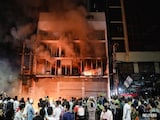Forty years after the Bhopal gas tragedy, its toxic waste cocktail is brewing afresh. About 350 metric tons of hazardous waste from the Union Carbide factory is set to be disposed of at the Treatment Storage Disposal Facility in Pithampur, Indore. The facility, though, has failed six previous tests on whether it can contain the emission which poses a significant cancer risk. And the cost will be far higher.
Twelve years ago, a German company, GIZ, offered to cart off the waste to Germany and dispose of it for Rs 22 crore. Disposing of the waste will now cost Rs 126 crore -- six-times the previous estimate.
The cost to health could be beyond math. The quantity to be disposed represents just 5 per cent of the total hazardous waste. But experts have warned that it could release large amounts of organochlorine, dioxins, and furans -- carcinogenic chemicals that are extremely harmful to humans and the environment. The incineration site in Pithampur has several villages within a distance of 2 km.
The World Health Organization has also warned that incineration at a faulty site could cause cancer.
"In the past, we protested against burning this waste. The then Chief Minister and Environment Minister assured us it wouldn't happen here. Despite these assurances, the waste is now set to be incinerated in Pithampur, a process that will take six months. If this happens, we will protest," said Gautam Kothar, the coordinator of the Lok Maitri Sansthan, an NGO.
This plan has been in the pipeline for long. But in 2012, the Madhya Pradesh government filed a petition in the Supreme Court, opposing it. The same year, at a cabinet meeting in Bhopal, former Chief Minister Babulal Gaur and then Environment Minister Jayant Malaiya strongly opposed incinerating the waste in Pithampur, fearing contamination of Yashwant Sagar Dam and Tarapura village.
No one was ready to take on the waste.
In 2007, Gujarat refused to incinerate Bhopal's waste despite financial incentives. In 2011, Maharashtra declined DRDO's proposal to incinerate the waste in Nagpur. Andhra Pradesh too refused to accept the waste.
"After I became the minister, we took a budget from the Government of India for the waste. We are making efforts with the centre, working with the cooperation of the central government. Tenders were issued for its execution even before I became the minister. Our expectation is that all that the waste should be burnt within a year. There is a decision regarding burning of the waste, and we cannot do anything about it," said Kunwar Vijay Shah, Minister, Gas Relief and Rehabilitation.
Lying for 40 years, the waste has contaminated soil and groundwater and pose a huge risk to generations. Data shows that from 2004 to 2018, toxic waste polluted groundwater in 42 settlements around the Union Carbide factory. In the last five years alone, the contamination has spread to 29 more settlements.
Deaths, survival, and challenges
While official figures of the death count vary - the central government pegs it at 5,295 while Madhya Pradesh cites 15,342, and the Indian Council of Medical Research (ICMR) estimates it to be 25,000 - the true extent of the tragedy goes beyond numbers.
Survivors are forced to live with the lingering effects of the disaster, facing health issues and inadequate support.
The groundwater of Brij Vihar Colony -- located around 3 km from the Union Carbide factory -- has been severely polluted by the factory's toxic waste. Arif Nagar, right across the Union Carbide factory, is still suffering from the aftereffects. Thousands of gas victims, their children, and grandchildren continue to be affected. Many children are born with mental and physical disabilities, and families cannot afford the necessary medical treatment.
The water in the affected areas is so contaminated that it leaves white marks and crusts on buckets and coolers within weeks. Residents report an increase in diabetes, heart attacks, and other serious health conditions.
From 2004 to 2018, toxic waste poisoned the groundwater of 42 settlements around the factory. Despite the Supreme Court's order to provide clean water, the contamination has spread to 29 more settlements in the last five years.
"The hard water caused me to have a heart attack," said Bhagwati Prasad Pandey, a resident of Bhopal's Brij Vihar Colony. "My family and the entire neighbourhood are suffering. The municipal corporation was ordered to provide clean water, but they refused, citing that it is a private colony."
"Since this colony was built, the water has been contaminated. Tests revealed heavy metals. Drinking this water has caused gallbladder issues, kidney stones, and skin infections. Despite multiple complaints, the municipal corporation has not provided clean water," said RS Pal, another resident.
Arif Nagar settlement, located right in front of Union Carbide, is a grim testament to the enduring impact of the disaster. Residents here continue to suffer from the contamination.
Amina, a resident, shares her heart-breaking story, "The water was so bad that many parts of the body were completely damaged. At the time of my child's birth, the doctor had said either the child will survive or the mother. Three years later, we came to know that he can neither speak nor hear. We are from a poor family, we face a lot of problems. Today, everyone in our house is sick because of water."
Danu Singh and Aashiya are among the many parents who bring their children and grandchildren suffering from severe health issues. Most of these children cannot speak or hear and communicate through gestures.
"The water is so bad that the food is not digested, there is constant vomiting. Our child is also mentally very weak, his hands and legs do not move," Mr Singh explains.
Aashiya adds, "Ever since my child was born, he has been mentally very weak. He had seizures in childhood. He is very weak. Sometimes, he has fever, sometimes, he has stomach pain. The water caused so much trouble that the child's liver was expelling water. His stomach had become as hard as stone."
In 2014, the United Nations Environment Programme (UNEP) offered to assess the toxic waste, but the government ignored the offer.
Kamla, a resident, says, "It has been 30 years, but even today I get itching and it does not go away for a long time."
Another resident, Batham, recounts, "We are facing troubles ever since the gas leak. Neither do we get proper water, nor are we able to live comfortably. Even after so many years, we have to take medicines. The water coming here is contaminated, it is causing many diseases."
"My whole family was there when this incident happened. We all started running as the gas level increased. We had to face many problems due to this gas. Even now there is pain, burning sensation in the eyes, blood pressure, and shortness of breath. Due to contamination of water, there was pain and burning sensation in the stomach. We have to collect water from different places. My grandson is six years old, but even today he has difficulty in walking, sitting, and speaking properly," shares Chandrama Devi, a resident.
Experts believe Union Carbide and Dow Chemical should be held accountable under the Polluter Pays Principle for the disposal of this toxic waste, but no action has been taken against these companies, which claim they are not subject to Indian courts.















